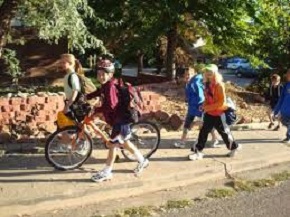
Children who walk, ride or scoot to and from school are implementing positive habits that can lead to good health for life.
South Western Sydney Local Health District health promotion director Mandy Williams says that setting healthy examples and encouraging children to be active from childhood promoted healthy, life long habits.
“Regular physical activity brings children so many health benefits, like building strong bones and muscles, maintaining a healthy weight, improving balance and posture, maintaining and developing flexibility and boosting confidence and self esteem,” Ms Williams said.
“The biggest hurdle is often finding time, but with a little bit of planning parents can help turn new activities into regular, beneficial habits.
“Children should get at least 60 minutes of physical activity each day, but only 19 per cent of Australians aged five to 17 meet the recommended Australian physical activity guidelines.
“This 60 minutes doesn’t need to occur all at once, it can be accumulated throughout the day with a combination of moderate to vigorous activities,” she said.
While 64 to 85 per cent of children participate in some form of organised sport, the 2015 Active Healthy Kids Progress Report Card shows less than half of all primary school aged children travel to school using active transport at least once a week.
Evidence suggests active commuting provides children with a number of health benefits including increased physical activity, six to eight times higher energy expenditure and three to nine times higher levels of cardiovascular fitness.
“Many adults remember walking or cycling to school, but today, most primary school children travel to and from school by car, even if they live within walking distance of their school.
[social_quote duplicate=”no” align=”default”]“For families who live some distance from school, try parking the car a good distance away from the school and walk the rest of the way, or walk to the bus stop instead of driving,” she said.[/social_quote]
Ms Williams encouraged parents to consider whether walking or cycling to school was possible and safe.
“Children should always wear a helmet when riding their bike, and if walking, children under 10 should hold an adult’s hand when around traffic and when crossing the road.
“If it’s not possible for your child to walk or ride a bike to school, consider some after school activities like team sports or even encourage them to kick a ball around with other local kids,” she said.
Be a good role model if you accompany kids to school
• Here’s some suggestions to guide you to maximise your child’s experience for walking to school.
1. Always allow more time when walking with children. They have little legs and need more time to travel the same distance.
2. Use the walking time to explore their surroundings and an opportunity for outdoor education by looking at the flowers and trees you see along the way. Name the flowers and trees you see, to the kids, if you can’t name it, look it up and learn together.
3. Teach the children road rules and to respect the road, be a good role model for them and don’t break the law.
4. Children always like to have a friend to walk with; it makes the walk more fun. It could be a good idea to organise a group of children to walk to school together or take turns with families to escort the children to school.
